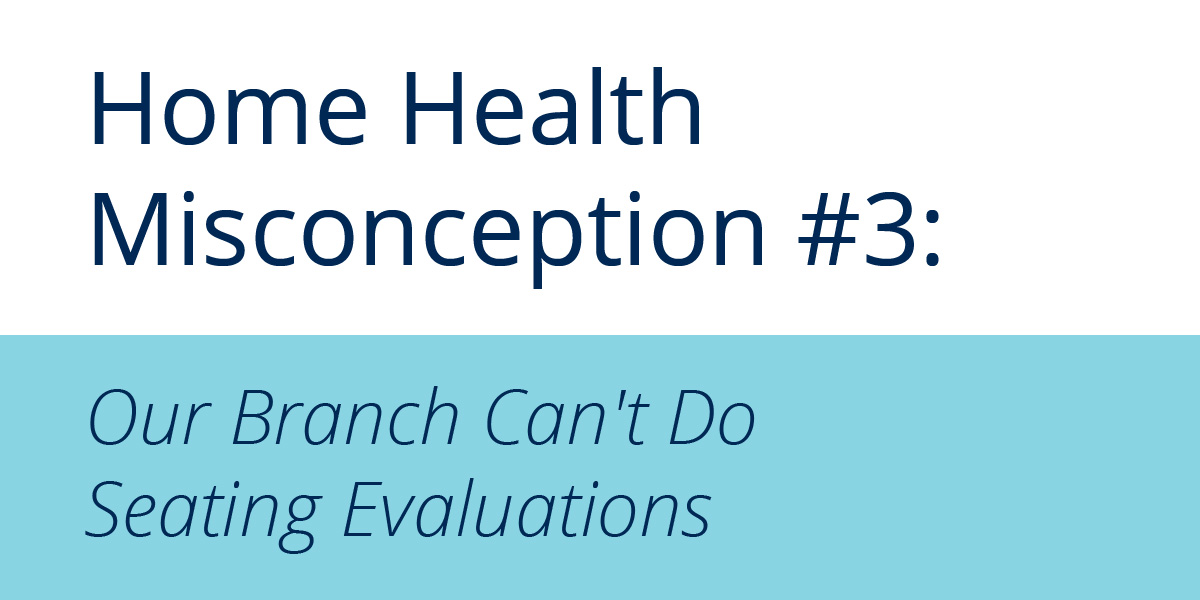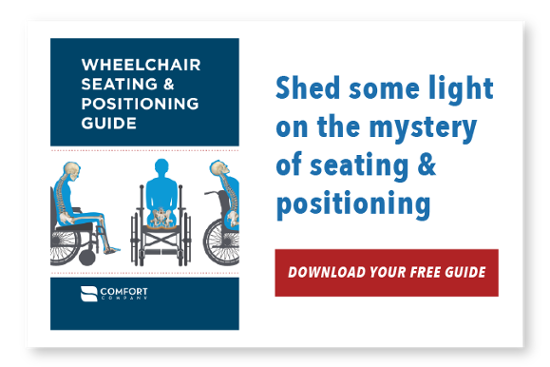Part 4 in our series about Seating & Wheeled Mobility in Home Health. See Part 1, Part 2, and Part 3.
We’re continuing to look at common misconceptions of seating and wheeled mobility in the home health setting. So far, we’ve addressed the misconception that someone else will deal with seating and wheeled mobility and that there isn’t a need in home health for wheelchair seating and positioning.
Misconception #3: Our branch can’t do seating evaluations
Some branch managers have had the experience of receiving physician’s orders that read “PT evaluation for a wheelchair." This then restricts the PT to a single evaluation which is not an effective use of time and cost to the branch. It doesn’t warrant opening an episode for just one visit. This may be a reason why a therapist thinks they can’t do seating evaluations in Home Health. But here are two scenarios to consider:
- Anyone needing a wheelchair not only needs an evaluation, but they need to trial equipment and be trained on proper use.
- If a client is needing a wheelchair, they more than likely will have other therapy needs. For example, learning to do self-care at wheelchair level, transfers to the commode or bed, transfers in/out of the care. The wheelchair evaluation actually becomes a part of the complete plan of care
So, what can we do?
This answer is two-fold.
First, the physicians need to be educated to use more appropriate language such as “PT to evaluate and treat for mobility needs”. This can be done when an incomplete order is received like the one mentioned earlier. The PT can call the office and request that the order be changed to “PT to evaluate and treat for mobility needs” and explain why the change is being requested: to ensure that the client gets the most appropriate equipment, and gets appropriate training to use the equipment during ADL’s. The branch marketing managers could also call on local physicians who are making these referrals and educate them on the importance of incorporating treatment when a client needs a wheelchair.
The next person who may need to be educated is the Branch Manager and/or director of rehab. Because they are responsible for ensuring profitability of their teams, they rightly keep a close eye on how many visits are being made, and also the outcomes. It’s important that they understand two things:
- A wheelchair evaluation should never be just one visit, as explained above. It should be one part of a comprehensive plan of care.
- Providing clients with the most appropriate wheelchair and seating equipment should result in improved outcome scores on the OASIS. The following list describes some of the positive outcomes to expect when providing the most appropriate seating and wheeled mobility equipment:
-
- Providing the appropriate equipment will increase function and independence.
- Proper equipment will facilitate healing of existing pressure injuries and prevention of further skin breakdown.
- Appropriate equipment will decrease risk of falls and injuries and improve quality of life leading to patient satisfaction.
- The right seating system can prevent the development of or progression of postural abnormalities and contractures that could result in pain or decreased function.
- Providing the appropriate equipment will increase function and independence.
All of these positive outcomes are going to be reflected in your OASIS scores as well as those quality measured domains that we talked about earlier in the series with the Impact Act: incidence of pressure injuries, incidence of falls, and re-hospitalization.
Because of short rehab stays and the push to providing services at home, Home Health agencies need to be prepared to provide these services. If you’re interested in learning more, or think your branch would like more education on wheelchair seating and positioning, contact us at seating.education@permobil.com. We have resources that can help!
 Stacey Mullis, OTR/ATP
Stacey Mullis, OTR/ATP
Director of Clinical Marketing
Stacey serves as Director of Clinical Marketing for Permobil. A practicing OTR for over 20 years, she has experience in school-based pediatrics, inpatient rehabilitation, long term care, and home health. With her interest in wheelchair seating and positioning, Stacey engaged the challenges of providing appropriate seating in various clinical settings. She now uses this experience to develop programs and resources to educate clinicians on the principles of seating and wheeled mobility. She is passionate about equipping clinicians and through her previous role as Director of Clinical Education with Comfort Company and now with Permobil she has taught nationally and internationally to increase therapist capacity in this specialty area. Mullis graduated from Western University in London, Ontario, Canada with a BA Linguistics and BSc Occupational Therapy. She is a member of the NCOTA, CTF Executive Board, NRRTs, RESNA, and AOTA.

